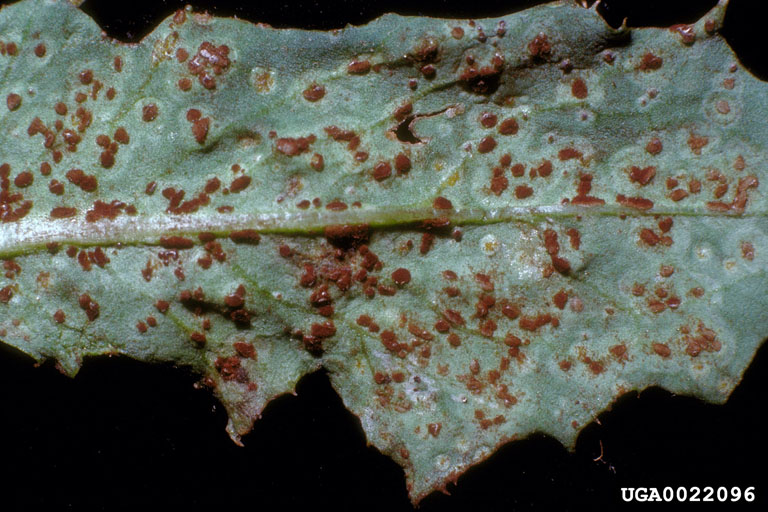Fungus: Uredinales
rush skeletonweed rust
Biological Control Agent Links Infected rush skeletonweed-photo-2 Infected leaves Close Up of Fungus Damage Damaged rush skeletonweed
Photo at right courtesy of Eric Coombs, Oregon Department of Agriculture www.forestryimages.org/
Origin: Eurasia (2)

Description: Puccinia chondrillina is fungus, a rush skeletonweed rust. This weed is very quickly spreading in the U.S. The weed is closely related to dandelions and chicory. This fungus infests rush skeletonweed. (1)
Life Cycle: Rust brown pustules are surrounded by yellow tissue that infects the bottom and top surfaces of the leaf of the seedling. Spores then form in the pustules, which are spread by rain and wind. These then attach themselves to other rush skeletonweed plants. once newly infected, new pustules form in 12-16 days. Heavy infections of the rust kill seedlings. Infected plants show signs of reduced growth and reproduction. These pustules are dark brown and are dormant over winter. Sexual stage of fungus produced in spring of the following year. (3)
Effects: The rust becomes destructive after the spores formed by the pustules attach themselves to the skeletonweed. This fungus attacks the upper and lower parts of the leaves causing reduced growth and reproduction. (1)
Introduction/Establishment: First introduced to the U.S. in 1977. It is now found in California, Oregon, Idaho, Maryland, Virginia, and Washington. (1)
Habitat: Anywhere rush skeletonweed is found. (3)
Collection, Transfer, and Redistribution: To collect the rust, you need to collect infected rush skeletonweed plant matter. Spores are distribute by rain and water. The best time to release the rust is in the evening. Cool, moist conditions are better suited for the release. (3)
Related Links
http://mtwow.org/bio-control-rush-skeleton-links.html
http://el.erdc.usace.army.mil/pmis/biocontrol/html/puccinia.html
http://www.fs.fed.us/rm/ecology/studies/biocontrol/rsw/
http://www.for.gov.bc.ca/hfp/pubs/interest/bioagent/rush.htm
http://www.integratedweedcontrol.com/insects.htm#rush
http://www.invasive.org/
http://24.114.142.233/nbs/ipcan/skeleton.html
http://www.nwcb.wa.gov/weed_info/skeleton.htm
http://www.cdfa.ca.gov/phpps/ipc/weedinfo/chondrilla-juncea.htm
http://www.publish.csiro.au/paper/AR9740459.htm
http://www.anbg.gov.au/cpbr/program/ub2002/burdon_staff.htm
http://www.symposium.ars.usda.gov/proceedings01.html
http://okanogancounty.org/nw/Biological%20Control.htm#Bio-Agents%20Available%20for%20Rush%20Skeletonweed:
http://bugs.bio.usyd.edu.au/Mycology/UsesOf_Fungi/primaryProduction/BiologicalControl/weeds.shtml
Bibliography
(1) Piper, Gary. "Rush Skeletonweed Rust." ---. Washington State University. 28 Jan. 2005. <http://el.erdc.usace.army.mil/pmis/biocontrol>.
(2) "Rush Skeletonweed." 04 May 2003. Ecology and Management of Northern Rocky Mountain Forests. 8 Jan 2005. <http://www.fs.fed.us/rm/ecology/studies/biocontrol/rsw/ >.
(3) Jones, Mariah. "Puccinia chondrillina." 02 June 2004. University College of the Cariboo. 03 Feb 2005. <http://www.for.gov.bc.ca/hfp/noxious/Bioagents/Long/puccinia1.htm>.
By: Bo Carey 2/10/05.
mtwow.org HOME Back to Biological Control